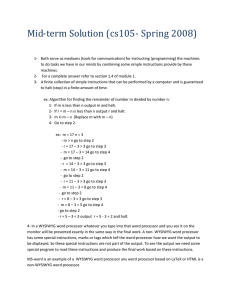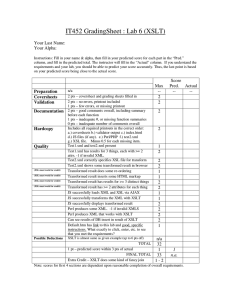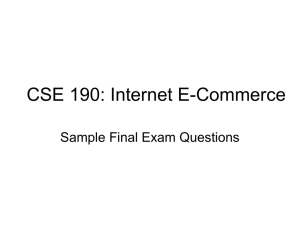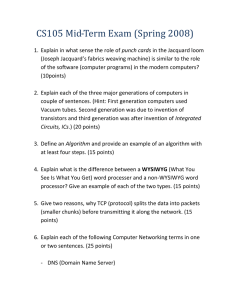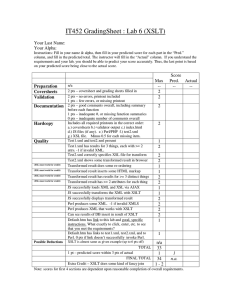XSL XSLT and XPath 26-Jul-16
advertisement
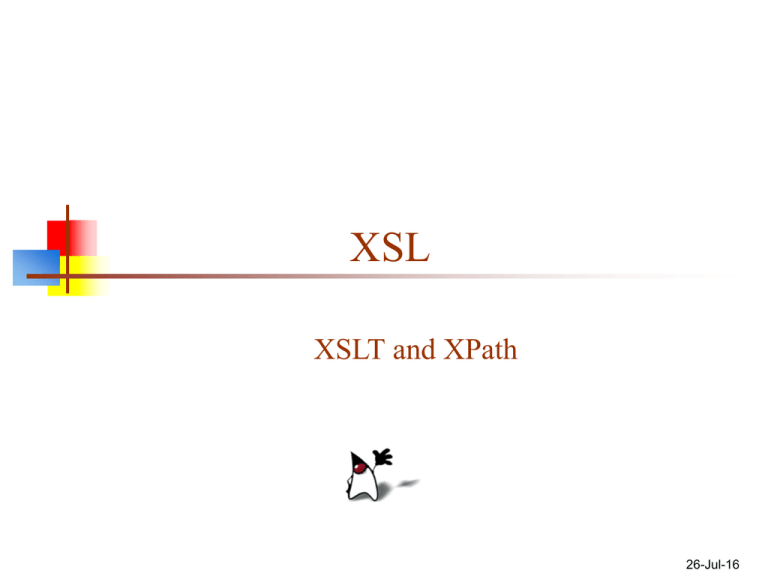
XSL XSLT and XPath 26-Jul-16 What is XSL? XSL stands for Extensible Stylesheet Language CSS was designed for styling HTML pages, and can be used to style XML pages XSL was designed specifically to style XML pages, and is much more sophisticated than CSS XSL consists of three languages: XSLT (XSL Transformations) is a language used to transform XML documents into other kinds of documents (most commonly HTML, so they can be displayed) XPath is a language to select parts of an XML document to transform with XSLT XSL-FO (XSL Formatting Objects) is a replacement for CSS We might or might not cover XSL-FO in this course 2 How does it work? The XML source document is parsed into an XML source tree You use XPath to define templates that match parts of the source tree You use XSLT to transform the matched part and put the transformed information into the result tree The result tree is output as a result document Parts of the source document that are not matched by a template are typically copied unchanged 3 Simple XPath Here’s a simple XML document: <?xml version="1.0"?> <library> <book> <title>XML</title> <author>Gregory Brill</author> </book> <book> <title>Java and XML</title> <author>Brett McLaughlin</author> </book> </library > XPath expressions look a lot like paths in a computer file system / means the document itself (but no specific elements) /library selects the root element /library/book selects every book element //author selects every author element, wherever it occurs 4 Simple XSLT <xsl:for-each select="//book"> loops through every book element, everywhere in the document <xsl:value-of select="title"/> chooses the content of the title element at the current location <xsl:for-each select="//book"> <xsl:value-of select="title"/> </xsl:for-each> chooses the content of the title element for each book in the XML document 5 Using XSL to create HTML Our goal is to turn this: <?xml version="1.0"?> <library> <book> <title>XML</title> <author>Gregory Brill</author> </book> <book> <title>Java and XML</title> <author>Brett McLaughlin</author> </book> </library > Into HTML that displays something like this: Book Titles: • XML • Java and XML Book Authors: • Gregory Brill • Brett McLaughlin Note that we’ve grouped titles and authors separately 6 What we need to do We need to save our XML into a file (let’s call it books.xml) We need to create a file (say, books.xsl) that describes how to select elements from books.xml and embed them into an HTML page We do this by intermixing the HTML and the XSL in the books.xsl file We need to add a line to our books.xml file to tell it to refer to books.xsl for formatting information 7 books.xml, revised <?xml version="1.0"?> <?xml-stylesheet type="text/xsl" href="books.xsl"?> <library> <book> <title>XML</title> This tells you where <author>Gregory Brill</author> to find the XSL file </book> <book> <title>Java and XML</title> <author>Brett McLaughlin</author> </book> </library > 8 Desired HTML <html> <head> <title>Book Titles and Authors</title> </head> Red text is data extracted <body> from the XML document <h2>Book titles:</h2> <ul> <li>XML</li> <li>Java and XML</li> Blue text is our </ul> HTML template <h2>Book authors:</h2> <ul> <li>Gregory Brill</li> We don’t necessarily <li>Brett McLaughlin</li> </ul> know how much data </body> we will have </html> 9 XSL outline <?xml version="1.0" encoding="ISO-8859-1"?> <xsl:stylesheet version="1.0" xmlns:xsl="http://www.w3.org/1999/XSL/Transform"> <xsl:template match="/"> <html> ... </html> </xsl:template> </xsl:stylesheet> 10 Selecting titles and authors <h2>Book titles:</h2> <ul> <xsl:for-each select="//book"> Notice the <li> xsl:for-each <xsl:value-of select="title"/> loop </li> </xsl:for-each> </ul> <h2>Book authors:</h2> ...same thing, replacing title with author Notice that XSL can rearrange the data; the HTML result can present information in a different order than the XML 11 All of books.xml <?xml version="1.0"?> <?xml-stylesheet type="text/xsl" href="books.xsl"?> <library> <book> <title>XML</title> <author>Gregory Brill</author> </book> <book> <title>Java and XML</title> <author>Brett McLaughlin</author> </book> Note: if you do View Source, </library > this is what you will see, not the resultant HTML 12 All of books.xsl <?xml version="1.0" encoding="ISO-8859-1"?> <xsl:stylesheet version="1.0" xmlns:xsl="http://www.w3.org/1999/ XSL/Transform"> <xsl:template match="/"> <html> <head> <title>Book Titles and Authors</title> </head> <body> <h2>Book titles:</h2> <ul> <xsl:for-each select="//book"> <li> <xsl:value-of select="title"/> </li> </xsl:for-each> </ul> <h2>Book authors:</h2> <ul> <xsl:for-each select="//book"> <li> <xsl:value-of select="author"/> </li> </xsl:for-each> </ul> </body> </html> </xsl:template> </xsl:stylesheet> 13 How to use it In a modern browser, just open the XML file Older browsers will ignore the XSL and show you the XML contents as continuous text You can use a program such as Xalan, MSXML, or Saxon to create the HTML as a file This can be done on the server side, so that all the client side browser sees is plain HTML The server can create the HTML dynamically from the information currently in XML 14 The Result Firefox Safari 15 The result (in IE) On Windows On Macintosh 16 The End 17

